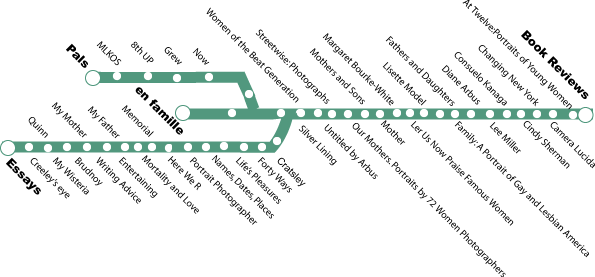 In 1981, after Harvey and I had renovated our house and Isaac was in
kindergarten, I began renting the camera one day a month. The camera was a
t the School of the Museum of Fine Arts and for the daily fee, I got film
, the camera, the studio and the help of John Reuter, now the Director of
Polaroid's New York Studio.
In 1981, after Harvey and I had renovated our house and Isaac was in
kindergarten, I began renting the camera one day a month. The camera was a
t the School of the Museum of Fine Arts and for the daily fee, I got film
, the camera, the studio and the help of John Reuter, now the Director of
Polaroid's New York Studio.
The Museum School was nervous about young children and pets of any kind were absolutely forbidden. A huge obstacle was that the building was closed on Saturdays and Sundays. At the start of each monthly session, I had to set up the lights and the backdrop paper from scratch. When peopl e called, I'd have to say " I'm only shooting on Thursday the 24th from nine to five. No animals." It didn't take long for me to see that I nee ded a camera in my own studio.
 In the winter of 1987 I heard that one of the four other cameras was com
ing back from Japan. I lobbied Eelco Wolf, Barbara
Hitchcock, John McCa
nn and Bob Chapman, at the Artists Support Program and the Large Format
Department of Polaroid to lease it to me. One cold morning Harvey and I
met Eelco outside 955 Mass Ave, a handsome eight-story office building a
bout roughly equidistant from MIT, Harvard and the Polaroid Corporate Hea
dquarters, to show him where I wanted to rent a studio that befitted the
camera. Eelco considered the building, considered the location and considered the typed "business plan" I presented to him. He said he was willi
ng to give me a chance. I took out a bank loan from the Cambridge Trust
Co. where I had had an account since l96l, and bought lights. Thus I bec
ame the only photographer to have a Polaroid 20x24 in her studio. (The others
are in Edwin Land's laboratory, and in Polaroid studios in New York, in
Germany, and at Massachusetts College of Art.)
In the winter of 1987 I heard that one of the four other cameras was com
ing back from Japan. I lobbied Eelco Wolf, Barbara
Hitchcock, John McCa
nn and Bob Chapman, at the Artists Support Program and the Large Format
Department of Polaroid to lease it to me. One cold morning Harvey and I
met Eelco outside 955 Mass Ave, a handsome eight-story office building a
bout roughly equidistant from MIT, Harvard and the Polaroid Corporate Hea
dquarters, to show him where I wanted to rent a studio that befitted the
camera. Eelco considered the building, considered the location and considered the typed "business plan" I presented to him. He said he was willi
ng to give me a chance. I took out a bank loan from the Cambridge Trust
Co. where I had had an account since l96l, and bought lights. Thus I bec
ame the only photographer to have a Polaroid 20x24 in her studio. (The others
are in Edwin Land's laboratory, and in Polaroid studios in New York, in
Germany, and at Massachusetts College of Art.)
Eric Harrington and Alan Hess helped me set up my studio. Peter Bass taught me how to run the camera by myself. I went through two cases of fil m, almost eighty exposures, and made every mistake possible before I got a feel for the rhythm of the rollers and the timing of the motor. I bega n to understand that the colored "fringe" at the top of the image was mad e by the pod splitting open, that the black bar at the top and bottom of the image was from the rollers, that the chemicals at the bottom of the i mage were affected by how I peeled apart the image. I learned little tri cks of peeling apart and little tricks of timing. I got used to thinking of vertical images (the camera can't work on the horizontal because of t he rollers). I learned to use filters to regulate the color of the film. I made notes on the floor of my studio so that I would know the right le ns setting for different distances from my subjects. Finally, on May 27t h, 1987, I was in business.


| Next | Back | Elsa Dorfman's Home Page |
Find Elsa's Books
Please change your links and bookmarks to elsadorfman.com!
Elsa thanks her cybergodmother, photo.net, her longtime, most generous host at furfly.com, and her current web host Mike Sisk at TCP/IP Ranch, LLC.
Copyright 1970-2010 © Elsa Dorfman.
Inquiries for the use of Elsa's content are welcomed!
Please
read these guidelines.
Contact
Elsa Dorfman via email or send Website Feedback to her webmaster.






